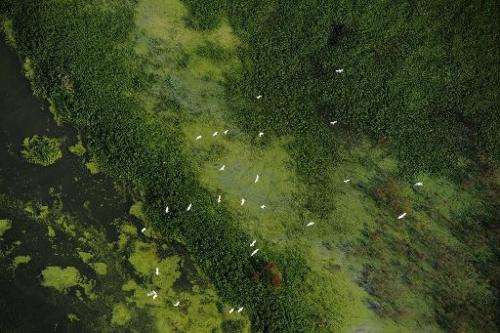Australia migratory bird levels plunge from Asia development

Coastal developments in northeast Asia are threatening the survival of Australian migratory shorebirds, a study has found, with some species experiencing population declines of up to 75 percent over the last two decades.
Some 36 migratory shorebird species, numbering between three to eight million, fly to Australia each summer from breeding sites in the Russian and Alaskan Arctic.
They stop at tidal flats in China and North and South Korea to refuel during their 20,000-kilometre (12,400-mile) annual journey.
But the destruction of those habitats over the past few decades has seen a marked decline in the population of such birds, including the eastern curlew and the curlew sandpiper, conservation biologist Nick Murray told AFP on Wednesday.
"Each year there have been fewer and fewer shorebirds seen in Australia," Murray, from the University of New South Wales, said of the changes that prompted the study into the Yellow Sea tidal flats, which was published in the journal Austral Ecology this month.
"We use satellite remote sensing to look at the changes in the habitats around the Yellow Sea region—which is northeastern China, North Korea and South Korea—and found that about 65 percent of those habitats that shorebirds use have been destroyed over the last 50 years."
Murray and researchers Richard Fuller, from the University of Queensland, and Ma Zhijun, from China's Fudan University, found the main threat to the tidal flats—wetlands also known as mudflats—was coastal development.
Some of the intertidal habitats have been transformed into industrial and agricultural lands, as well as used for aquaculture, stripping away the birds' feeding grounds, the study found.
Pollution, overfishing and algal blooms in these areas were also contributing factors.
The eastern curlew, the largest shorebird that comes to Australia, is one species that is globally threatened.
It has seen its population levels plunge by up to 70 percent over the past two decades, Murray said, while the curlew sandpiper has declined by 75 percent in 20 years, according to the data used in the study.
"The birds will fly for 6,000 kilometres non-stop and use up all their energy trying to make it to that refuelling station," he said.
"When they get there and the habitat's not there anymore and they are unable to refuel, it's very likely that they will just die."
While the population declines are a "very large problem", governments in the region are trying to tackle the threats, Murray said.
This includes identifying protected area sites and working with provincial leaders to reduce pollution and aquaculture impacts, he added.
© 2015 AFP














